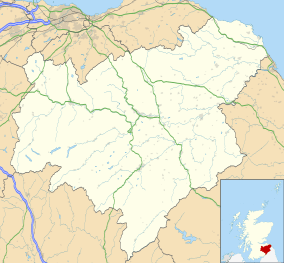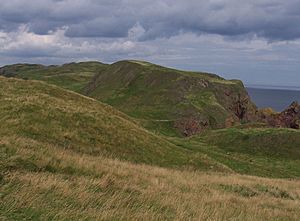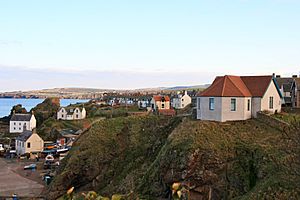St Abb's Head facts for kids
Quick facts for kids St Abb's Head National Nature Reserve |
|
|---|---|
|
IUCN Category IV (Habitat/Species Management Area)
|
|

St Abb's Head seen from the south near the village of St Abbs
|
|
| Location | Berwickshire, Scotland |
| Area | 77.2 ha (191 acres) |
| Designation | NatureScot |
| Established | 1984 |
| Owner | National Trust for Scotland |
| St Abb's Head National Nature Reserve | |
St Abb's Head is a rocky piece of land that sticks out into the sea. It is located near the village of St Abbs in Berwickshire, Scotland. This area is a special nature reserve. It is looked after by the National Trust for Scotland. The St Abb's Head Lighthouse was built by two brothers, David Stevenson and Thomas Stevenson. It started working on February 24, 1862.
Contents
How St Abb's Head Was Formed
The rocks at St Abb's Head tell an amazing story. The layered rocks around the Head are called greywacke and siltstone. They formed at the bottom of the sea a very long time ago, between 460 and 410 million years ago.
St Abb's Head itself is made from hard volcanic rock. This rock formed about 400 million years ago from lava flowing out of volcanoes. The different types of rock explain why the Head looks different from the nearby cliffs.
Over time, the softer layered rocks wore away. This left the high headland made of harder volcanic rock. Even this tough rock has been shaped by the sea. It now has steep channels and sea stacks, which are perfect for seabirds to nest on.
The hard rocks of the Head are separated from the softer rocks by a large crack in the earth, called the St Abb's Head Fault. This fault created a low valley. The man-made Mire Loch sits in this valley. Long ago, when sea levels were higher, this valley would have been filled with water. This would have made St Abb's Head an island.
Amazing Wildlife at St Abb's Head
St Abb's Head is home to a huge group of seabirds, with about 60,000 birds living here.
Seabirds and Their Nests
- Guillemots and razorbills nest on the tall rock stacks in the sea. Guillemots nest very close together in big groups. Razorbills prefer to nest in smaller groups or in pairs.
- Kittiwakes build their nests from grass and mud on the steep cliff faces.
- Fulmars like grassy ledges and cracks in the rocks.
- Other birds you might see include shags, herring gulls, and puffins.
Plants and Other Animals
Even though it's famous for birds, the reserve also has beautiful grasslands full of flowers. There is also a freshwater loch (lake). To protect the sea animals and plants, a special area called a Voluntary Marine Reserve was set up. This area goes south along the coast to the town of Eyemouth.
The land on the Head is used for grazing by sheep from Northfield Farm. This grassland is surprisingly rich in plants. In some spots, you can find more than 20 different kinds of plants in just one square metre!
At least 10 different types of butterflies live on the Head. This includes the northern brown argus, which is a rare butterfly in the UK. These butterflies drink nectar from flowers like wild thyme. Their caterpillars eat the leaves of rock rose. Areas where these plants grow are protected from sheep by fences.
Just a short walk from the lighthouse is Mire Loch. This is a lake that was created by people. It is about 600 metres (2,000 feet) long.
History of St Abb's Head
Ancient Monastery
About 0.5 kilometres (0.3 miles) southeast of the lighthouse is Kirk Hill. On top of this hill are the remains of a very old monastery. It was built in the 7th century by Saint Æbbe. Around the year 643 AD, Æbbe started the monastery on Kirk Hill. It was built inside an even older fort from the 6th century, called Urbs Coludi.
Both monks and nuns lived at the monastery. They lived in simple huts made from mud and branches. Æbbe was the abbess (leader) until she died around 680 AD. A few years later, the monastery accidentally burned down and was not rebuilt.
The settlement was protected by a huge turf wall, about three metres (10 feet) high. You can still see parts of this wall as a low ridge around the hill. These are the only signs left of Æbbe's 7th-century monastery. There are also faint outlines of buildings and a burial site from the 12th century. These are from a later chapel built in 1188 by monks from Coldingham Priory.
Fishing and the Lighthouse
On the north side of the Head is Pettico Wick Bay. This bay was a natural trap for salmon swimming along the coast. A fishing station was set up here in 1880 and was used until about 1950. A small dock was also built in the bay to bring supplies to the lighthouse.
Before the lighthouse, a signal station was built on the cliffs before 1820. The Northern Lighthouse Board decided a lighthouse was needed after a ship called the "Martello" sank in 1857. The St Abb's Head Lighthouse was designed by the Stevenson brothers. It helped ships find their way before and after they passed the Bell Rock and Isle of May lights.
The lighthouse started working on February 24, 1862. At first, it used oil for its light. It was changed to a brighter light in 1906 and to electricity in 1966. Finally, it became automated in 1993, meaning no one had to live there anymore. Before it was automated, three full-time keepers worked there. They also kept detailed weather records.
Shipwrecks Near St Abb's Head
Even with the lighthouse, some ships have been lost on the rocky coast near St Abbs.
- The cargo ship MV Nyon ran aground in thick fog on November 16, 1958. The crew was saved. The ship's back part was saved and rebuilt with a new front in the Netherlands. The original front part stayed at St Abbs until waves destroyed it.
- The Royal Navy ship HMS Pathfinder sank off St Abb's Head on September 5, 1914. It was the first ship ever destroyed by a self-propelled torpedo. A German U-boat, SM U-21, attacked it. 259 lives were lost. The writer Aldous Huxley saw the explosion while staying in St Abbs.
Visiting St Abb's Head
The National Trust for Scotland (NTS) has an information point at Northfield Farm. This place has an exhibition about St Abb's Head. It also has a coffee shop, an art gallery, and a textile shop. You can find maps there to help you walk around the Head. There are also guided walks led by a Ranger.
In March 2011, the new St Abbs Visitor Centre opened. It is in the old village hall, right on the cliff edge. This centre is for both visitors and local people. It offers free entry, interactive displays, a library, and old photos. It teaches visitors about the village's history, the rocks, and the local wildlife. From the building, you can see a wide view from St Abb's Head all the way to the harbour. A Scottish charity runs the centre.
Protecting St Abb's Head
St Abb's Head was made a national nature reserve in 1984. The National Trust for Scotland manages the reserve with help from NatureScot. The first part of the land was bought in 1980. Other parts were given as gifts or bought later.
St Abb's Head is important for wildlife. It has several other special protection titles:
- It is a Category IV protected area by the International Union for Conservation of Nature.
- It is part of the St Abb's Head to Fast Castle Site of Special Scientific Interest (SSSI). This covers the coast north to Fast Castle Head.
- The areas between high and low tide are part of the Berwickshire Coast (Intertidal) SSSI.
- The reserve is within the St Abb's Head to Fast Castle Special Protection Area (SPA).
- The St Abb's Head to Fast Castle coast is also a Special Area of Conservation (SAC). The seas offshore are part of another SAC, the Berwickshire and North Northumberland Coast SAC. This area goes into England too.
Images for kids
See also
 In Spanish: Cabo de St. Abb para niños
In Spanish: Cabo de St. Abb para niños







